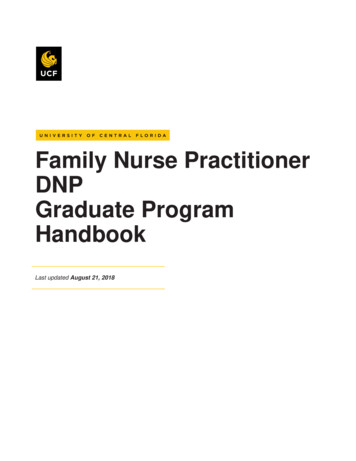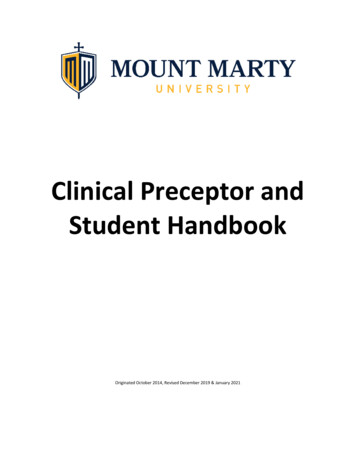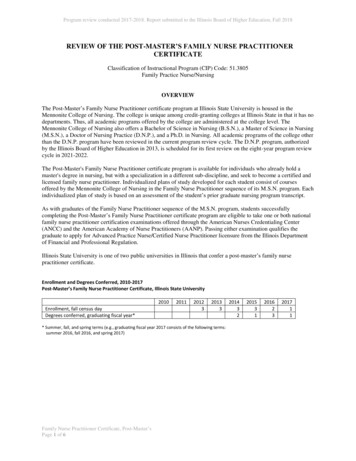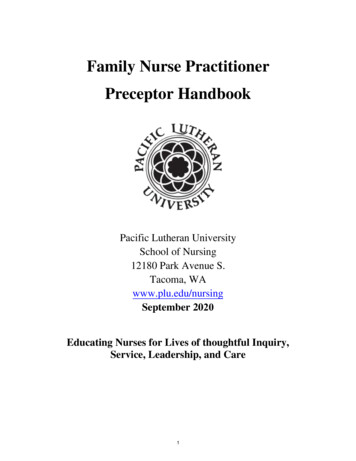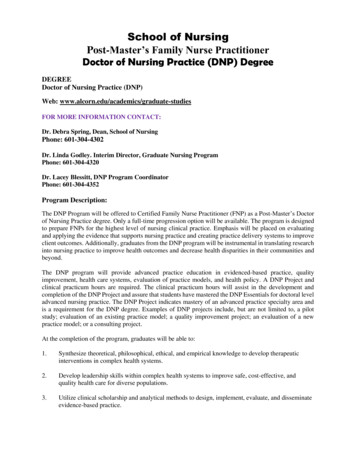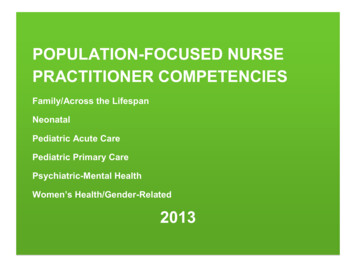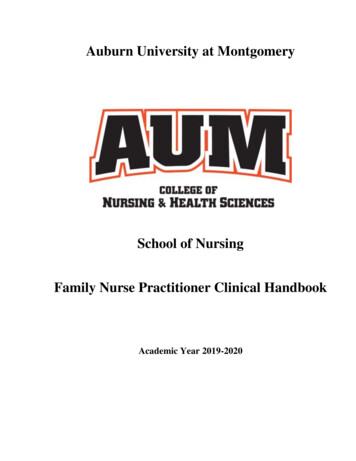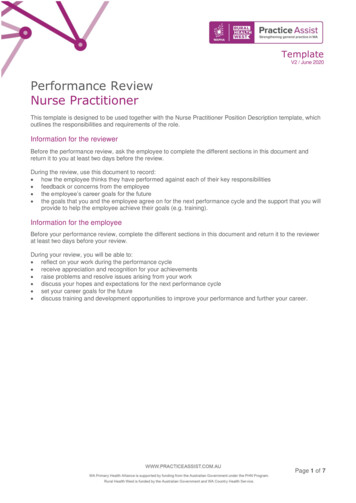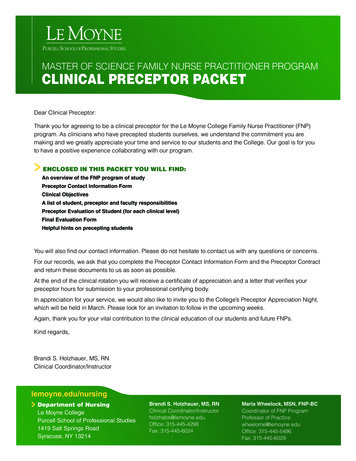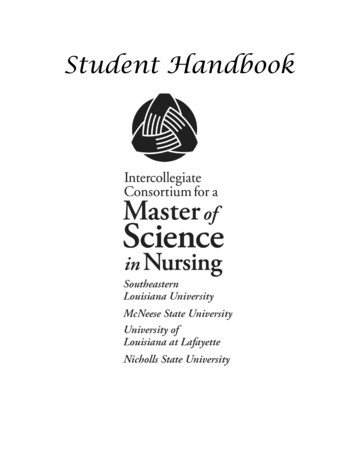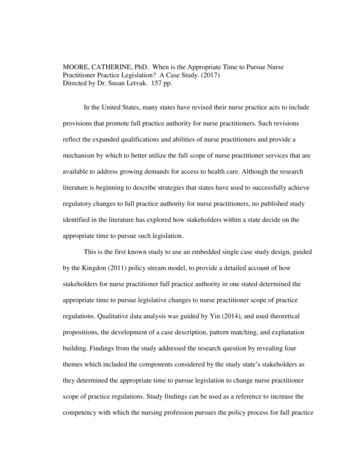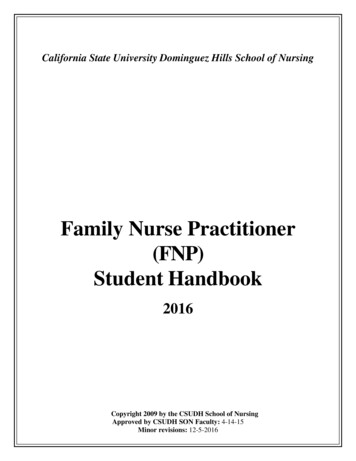
Transcription
California State University Dominguez Hills School of NursingFamily Nurse Practitioner(FNP)Student Handbook2016Copyright 2009 by the CSUDH School of NursingApproved by CSUDH SON Faculty: 4-14-15Minor revisions: 12-5-2016
2Table of ContentsWelcome & Overview of the FNP Program . 3Admission Requirements for the MSN-FNP Program . 4Admission Procedure for Family Nurse Practitioner Option . 5The Family Nurse Practitioner Curriculum . 8The Faculty Role . 8The Student Role . 9The Clinical Instructor’s Role . 10The Preceptor Role . 11The Site Evaluator Role . 11The Clinical Experience: Clinical Requirements and Preparation . 12Preceptor Qualifications . 14Learning Contract .15Clinical Site Affiliation Contracts . 15Learning Activities . 16Academic Policies . 17Professional Conduct, Confidentiality, Ethics, and Professional Behavior . 17Impaired Behavior. 18Dismissal Policy . 18Problem Resolution . 18Requirements for Online Classes . 19Credit for Prior Primary Care Experience . 20Additional Resources . 20Appendix A . 21SON Mission, Philosophy and Program Objectives . 21-22Appendix B . 23Recommendation for Graduate Study in Nursing . 23Reflection Statement .24Appendix C . 25Spring and Fall Admits Program of Study . 25Fall Admits Program of Study .26Appendix D . 27-33FNP Options Course Descriptions/Information Learning Contracts . 27-29Learning Contract Objectives MSN 558 (FNP I) . 30Learning Contract Objectives MSN 568 (FNP II) . 31Learning Contract Objectives MSN 578 (FNP III) . 32Learning Contract Objectives MSN 588 (FNP IV) . 33Appendix E . 34School of Nursing Full-Time Faculty and Office Information . 34Appendix F. 35Electronic Log System for FNP Courses . 35Appendix G . 36Clinical Requirements Form and CBC Instructions . 36Appendix I . 41Evaluation of the Preceptor by the Site Evaluator . 41Evaluation of the Preceptor by the Student . 42Appendix J .43Portfolio Checklist . 493
3Welcome & Overview of the FNP ProgramWelcome to the Family Nurse Practitioner (FNP) program in the School of Nursing (SON)at California State University, Dominguez Hills (CSUDH). Our faculty and clinicalinstructors are committed to facilitating the learning of our nursing students in professionaladvanced nursing practice. Please take time to review this Handbook, as it contains thepolicies and procedures utilized by the FNP faculty for all aspects of the program.The purpose of the FNP Handbook is to provide an orientation to the roles andresponsibilities of the student, instructor and preceptor in the School of Nursing courses.Whether you are an instructor, preceptor or student, please read the FNP Handbookcarefully to understand the roles of each and the interactions among all that are required forsuccessful learning in clinical courses.The content of the FNP Handbook includes: Admission Policies The Faculty Role The Student’s Role The Instructor’s Role The Preceptor’s Role The Clinical Experience Problem Resolution Performance Course Units Policy for Clinical Placement Preceptorship Ethical Considerations AppendicesPlease note: All students, those conditionally accepted to the FNP program and thosewaiting for FNP role option admission decision, are responsible for the content in thishandbook. The FNP Handbook is updated and published each Summer and updated asneeded. Students who attend the mandatory orientation, and conditionally admitted to theFNP role option have access to the FNP advising site. All information is posted andfrequently updated on the advising site. Students are strongly encouraged to access theadvising site and FNP Handbook on a regular and ongoing basis. It also advised that eachstudent secure the University catalog in the year of admission for specific Universitypolicies.Overview of the Family Nurse Practitioner ProgramThe CSUDH School of Nursing offers the Family Nurse Practitioner Program for nurseswho want to develop advanced practice knowledge, skills and competencies in primary careof the family. Included in the course of study are advanced health assessment, advancepharmacology and advanced pathophysiology. In addition, comprehensive assessment andmanagement of common acute, chronic and complex health problems across the life spanwithin a culturally diverse environment comprise the curricular path. Travel to campus isrequired for Advanced Health Assessment and FNP role option courses. To receive theMSN degree, FNP students must complete 48 units of course work and achieve success inthe Culminating Experience.
4The FNP program, as part of the Master of Science in Nursing Program at CSUDH, isaccredited by the Commission on Collegiate Nursing Education (CCNE). The University isaccredited by the Western Association of Schools and Colleges (WASC).The FNP program meets the requirements of the California Board of Registered Nursing(BRN) and is a BRN-approved program. Graduates of this program are eligible to becertified as nurse practitioners in the State of California. Students who successfullycomplete this program are qualified to take the national certification examination as FamilyNurse Practitioners.The mission statement and MSN program objectives are located on the website andAppendix A of this handbook.Admission Requirements for the Master of Science Family NursePractitioner (FNP) ProgramA. Admission to the CSUDH MSN Program in good standing requires:* Completion of a baccalaureate degree program with a NLNAC- or CCNEaccredited upper division major in nursing (BSN) from a regionally accreditedinstitution or the equivalent as determined by the SON Student Affairs Committee.* Overall grade point average of 3.0 (on a four-point scale) or higher in the last 60semester (90 quarter) units of upper division course work attempted. Students notmeeting this grade point average requirement may be admitted to ConditionallyClassified status on the recommendation of the faculty.* Registered nurse licensure in the United States and California, unencumbered,unrestricted, with no disciplinary action pending or imposed.* Satisfaction of the Graduation Writing Assessment Requirement (GWAR) prior toentry into the program or by the completion of 9 graduate units.* Completion of prerequisite courses (see below).* Submission of a professional resume and a 100-200 word statement describing thecongruence of the applicant’s educational goals with the resources of the CSUDHMSN Program. Note: These are University requirements, and are separate from theFNP role option admission process.B. Pre-Requisite Courses for the MSN Program:Completion of a statistics course including probability and inferential; and introductoryresearch course or equivalent; a pathophysiology course; and a basic health assessmentcourse, including a skills lab. Specifically:Basic Health Assessment: An upper division, undergraduate course with clinical labexperience or equivalent.Basic Pathophysiology: An undergraduate course or equivalent.Statistics: An undergraduate course which includes probability and inferentialmeasures.Research: An introductory undergraduate course, or equivalent.
5C. Admission to the FNP Role Option:All students who apply to the FNP role option and meet the University’s MSN Programrequirements are admitted on a Conditional Basis, pending successful completion of theFNP Admission Procedure outlined below. NOTE: the FNP admissions is a 3 stepprocess.Admission Procedure for Family Nurse Practitioner OptionStudents desiring admission to the FNP role option will complete a two-step applicationprocess:Step 1: Apply for admission to the university at www.csumentor.edu. Assuming basicMSN admission criteria are met, all candidates who declare the FNP role option willbe admitted on a conditional basis.a) Conditionally admitted students may enter a program of study for fall or springadmission. See the Program of Study in this document. Students must enroll inMSN 502 and MSN 528 sections dedicated to the FNP option in the first semester.Students are cohorted and preference is given to those students who follow theoutlined program of study outlined in Appendix C&D.b) All candidates must attend the mandatory FNP Orientation in which a FNP facultyreviews the proper submission of the FNP Portfolio, preparation for role option andother critical information. After attending the orientation, paying University fees andregistration in the required courses, students are granted access to the FNP Advisingsite. Orientation is held every August and January. It is advised that students attendthe orientation just prior to enrolling in the introductory courses MSN502 and MSN528.Step 2: Submit FNP Portfolio to the School of Nursing for Level I review(see information regarding deadlines in this document).a) For Level I review, the student will compile and submit a Portfolio consisting of thefollowing:i.Letter of intentii.Curricula vitae (resume) all information must include dates.iii.Unofficial transcripts for ALL college work. Transcripts of RN training arerequired.iv.3 reference letters using the Recommendation for Graduate Study form includedin this document in (Appendix B). Reference letters should reflect the student’sprofessional ability, not personal references. Letters are submitted to the advisingsite within the portfolio, not mailed individually to the school of nursing.v.Reflection statement (see guidelines included in this document in (Appendix B)
6vi.Evidence of admission and current enrollment in graduate nursing courses.vii.Proof of attendance of orientationviii.Signed Program of StudyThe completed Portfolio is to be scanned in the prescribed order above into one pdf fileand uploaded to the FNP Advising Site in the Submission area. Office supply stores andcopy centers are able to quickly and accurately scan documents provided to them in theorder specified. Please include only the above documents in the scanned submission. PDFDocuments are read electronically and must be legible and appear upright on the computerscreen. Incomplete submissions or submissions not prepared as specified will not bereviewed and will be returned to the student as incomplete. This may seriously delay theFNP admission process. Note: only admitted and matriculated students have access theFNP Advising Site and the Submissions area for uploading portfolios. (Appendix J)The Portfolio will be scored at the Level I review by the FNP Admissions Committee. Ifqualified, the student will be approved to proceed to a Level II review. Note: preference isgiven to students following the Program of Study and cohorted.Prospective FNP Role Option students will follow one of the two program of studies, eitherFall admission of Spring admission. Please consult Appendix C for the sequence of coursework required. All students desiring admission to the FNP Role Option are expected tofollow the appropriate program of study.Step 3: Submit the Role Option Eligibility Form and GWAR/GWE scoredocumentation and proceed to Level II review by the FNP AdmissionsCommittee.Upon completion of MSN 526 Pharmacology, MSN 527 Advanced Health Assessment,MSN 528 Advanced Pathophysiology, MSN 530 Research Utilization in Advanced NursingPractice, and the Graduate Writing Assessment Requirement (GWAR)/Graduate WritingExamination (GWE), the student will submit the Role Option Eligibility Form andGWAR/GWE score documentation and proceed to Level II review by the FNPAdmissions Committee. Level II includes rating of MSN 528, MSN 526, and MSN 527 GPA.All documents are submitted electronically through the advising site. No hard copies areaccepted.In the event the student does not meet the admission criteria after the Level II review, thestudent will have the option of selecting another role option by submitting a GraduateChange of Objective form or the student may choose to transfer to another university. Pleaseconsult the CSUDH catalog for a list of role options available in the School of Nursing.Students who are selected to begin the FNP role option after the Level II review areexpected to submit the Clinical Packet documentation. The guidelines are outlined in theFNP Handbook. The information is posted to the Advising Site according to published duedates. There are two categories of information that are required, 1) Student informationincluding license, CPR, immunizations, etc. and 2) Preceptor Information including learningcontract signed by preceptor and including course objectives, preceptor CV and license
7information from online license verification sites, and proof of valid contract between theuniversity and the preceptor. An independent agency is contracted to assist with clinicaldocumentation.FNP faculty will conduct a final evaluation and students will be notified of acceptance intothe FNP role option. Please note that the actual start date in role option courses may becontingent on space availability, as well as student qualifications.The following are due dates for the required documents:Application TermFNP Portfolio DueRole OptionEligibility Form DueClinical Packet DueFall termNovember 1stJune 20thJuly 15thSpring termApril 1stDec. 15thDec 31thExample: A student applying for admission to the FNP role option in the Fall 2015 will berequired to submit the FNP Portfolio by November 1, 2014, during their first semestertaking MSN 502 and MSN 528. The Role Option Eligibility is due on June 20th andClinical Information is due July 15. A student who applies for admission in the Spring 2016term is required to submit the FNP Portfolio by April 1, 2016, during their first semestertaking MSN 502 and MSN 528. The Role Option Eligibility is due Dec. 15th and theClinical Packet is due December 31. NO LATE OR INCOMPLETE SUBMISSIONSARE ACCEPTED. NO EXCEPTIONS.Change of Objective StudentsStudents who have already been admitted into another role option and want to change rolesto the FNP program are required to submit a Graduate Change of Objective form. Alldeadlines noted in this document are required of all students. If basic MSN admissioncriteria are met, if students follow the FNP admission procedures and students who submit aGraduate Change of Objective form may be admitted to the FNP option on a conditionalbasis. There is no guarantee of FNP admission with a change of objective alone.Preference is given to students following outlined program of study, and who arecohorted. It is advised that change of objective students reflect on their choice, as spacefor change of objectives students is limited.MSN Pathway StudentsThe MSN pathway program is for registered nurses with non-nursing baccalaureate degrees.Pathway students must participate in a MSN Pathway workshop during which the pathwayadvisor will determine the BSN courses required for the MSN program.Pathway students who desire the FNP will complete all required BSN courses prior tostarting the sequence of graduate courses outlined in the Handbook (see Appendix C).NOTE: All BSN courses must be completed prior to portfolio submission and application tothe FNP Role Option. It is advised to follow the Program of Study as closely as possible.
8The Family Nurse Practitioner CurriculumThe FNP curriculum is composed of core, advanced science and role-specific courses whichtotal 48 units. The FNP program includes didactic courses and practice- based clinical orrole performance courses. Each course is comprised of specific learning objectives,activities, and evaluation measures. The didactic courses present the nursing knowledge,theoretical concepts, models, and research that inform patient care and evidence-basedpractice. The clinical courses provide opportunities for students to apply knowledge;practice skills; plan, implement and evaluate interventions and programs; and learn the fullscope of the FNP role for which they are preparing.The curriculum is delivered primarily in web-based courses taught online taught through theInternet, or in hybrid format (web-enhanced). Web-based courses are available to studentsthrough the Blackboard application. Hybrid courses combine online learning with someclass sessions held on campus. MSN 527 Advanced Health Assessment and the FNP clinicalrole performance courses are taught in the hybrid format. On campus attendance ismandatory, the exact number of hours vary according to the course.Prior to the beginning of the Role Option Course, MSN 558, the student mustdemonstrate proficiency in performance of a complete history and physical exam ofwell adult, pediatric client and prenatal patient by successful completion of MSN 527Advanced Health Assessment. It is strongly advised that students take MSN 527 priorto the semester they anticipate starting the role performance courses. Coursedescriptions and objectives are found in Appendix D.The Faculty RoleThe members of the CSUDH School of Nursing faculty have doctoral and/or master’sdegrees related to their field of nursing practice. They serve as master educators andprofessional mentors for students and colleagues, as well as facilitators, instructors, rolemodels and resource persons in their particular area of expertise. The full-time faculty roleencompasses teaching, scholarship, and service, including practice in their field. The fulltime faculty and SON Student Services numbers are listed in Appendix E.The part-time faculty provide instruction in courses in their field, according to the needs ofthe program.As an instructor, the faculty guides and facilitates the learning process and evaluates thestudents according to the course objectives and the students’ performance of the learningactivities for a particular role outcome. Clinical instructors and site evaluators assesslearning opportunities and evaluate the student’s performance in the clinical setting.The SON Director, the SON Chair and FNP Program Director are the faculty whoadminister the School of Nursing programs. They are responsible for scheduling courses andoverseeing the contractual arrangements with the affiliated clinical sites. Together with thecourse faculty, they implement and interpret policies and procedures pertaining to theclinical learning component of the programs.Questions and correspondence regarding FNP admissions or FNP student advising shouldbe directed to the email addresses listed below. The SON FNP advising faculty will respondto these emails. Use of these emails will allow the SON FNP advising faculty to address
9student needs and respond in a timely manner.Director, SONFNP Program DirectorKathleen Chai, MSN, CNE, PhD, Sharon Johnson PhD, FNPCPHQ, kchai@csudh.eduGraduate CoordinatorTerri Ares, RN, PhD310-243-2644tares@csudh.eduStudent Services310-243-2120Information TechnologyHelpdesk310-243-2500Administrative Supportsondepartment@csudh.edu310-243-3596SON FAX310-516-3542The Student RoleThe School of Nursing students lead very full lives and may have difficulty making theireducational studies a priority at all times. Our students are seeking educational opportunitiesthat meet their own goals and build on their previous personal and professional experience.They are adult learners and the curriculum is designed for the adult learner.The faculty expects students who are adult learners to be self-directed and internallymotivated. The faculty recognizes that as adult learners mature, they become more diverseand vary widely in learning styles, motivation, prior experience and patterns of participationin educational programs. Therefore, our programs use the learning strategies that meet theadult learner’s need to participate in defining needs, goals, activities, and evaluation ofoutcomes.Faculty and clinical instructors try to incorporate and build upon the assumptions that theadult learner: Is self-directed.Has accumulated experiences that serve as a resource for learning.Has a need to relate learning to real-life situations.Wants to apply newly acquired knowledge and skills immediately.Incorporation of these assumptions into the educational experience facilitates and enhanceslearning and satisfaction.Specific tasks of the student include:1.Drafting a learning contract, seeking input from the course instructor aboutopportunities in the agency and documenting appropriate learning objectives,activities, and outcome measures on the learning contract objectives formappropriate to the FNP role option level. (Appendix D)2.Fulfilling the learning contract that is mutually agreed upon by the student andinstructor.
103.Functioning within the framework and policies of the assigned agency.4.Seeking direct and indirect supervision from the instructor.5.Participating in conferences with the instructor and seeking feedback about progresstoward completing the learning contract.6.Maintaining an activity log, clinical journal, patient database, or other records (e.g.E-logs) as required by the instructor or preceptor. (Appendix F)7.8.Seeking assistance from the instructor if problems occur in fulfilling the learningcontract, or if a need arises to modify the contract.Coming on time and fully prepared to each clinical session.9.Informing the agency and instructor if unable to arrive at the agency as scheduled.10. Acting in an ethical and professional manner at all times.11. Fulfilling the time requirements as stated in the syllabus for each clinical course.12. Participating in group and individual conferences as scheduled by the instructor.13. Satisfactorily completing all course assignments.14. Evaluating the clinical experience and clinical agency on the standard courseevaluation forms, adding comments as desired.15. Becoming an adaptable and flexible learner.16. Strengthening their areas of weakness.17. Developing a long term plan and setting short term goals.18. Seeking safe opportunities to practice new skills.19. Communicating and behaving in a professional and civil manner.20. Rewarding themselves each step along the way.The Clinical Instructor’s RoleThe role of the clinical instructor is an important component of the clinical educationexperience. The instructor teaches the clinical course, assists in making arrangements forclinical experiences and oversees the student’s performance and clinical experience. She orhe works with the student to structure the learning experience and develop the learningcontract. The instructor monitors and assesses appropriate learning experiences to facilitatethe student’s achievement of the course objectives. The instructor is also responsible andaccountable for assuring that it is possible to meet the course objectives in a specific agency.
11The instructor communicates on a regular basis with the student regarding student progressand learning needs, and is available to resolve problems if they arise. The course instructoris responsible for evaluating the student’s work and assigning a final grade.Faculty who teach sections of the clinical courses may be full-time or part-time instructors.The content expert for each clinical course has the responsibility to coordinate the sectionsof the course and serves as a resource to the instructors.Specific clinical instructor responsibilities and activities include:1.Verifying the student’s readiness to begin the course (prerequisites met,documentation of immunity, etc, documented).2.Approving each student’s clinical site on the basis of established criteria and inconsultation with the appropriate agency designee.3.4.Providing guidance to the student in formulating the learning contract.Conferring with the student individually and in groups.5.Conducting group seminars.6.Submitting copies of the learning contracts and evidence of learning outcomes tothe School of Nursing office.7.Assigning student grades following review of the learning outcome measuresidentified in the course and the learning contract.8.Submitting grades by the published deadline using the online grading system.9.Forwarding all evaluation forms to the Program Coordinator.The Preceptor RolePreceptors are responsible for providing role modeling, direct patient supervision,professional interactions, and sharing expertise and experience. Preceptors are expected tovoice concerns when student behaviors are in question or patient safety is of issue.Preceptors do not assign final gradesPreceptors are provided with a learning contract, course descriptions and objectives,syllabus, clinical evaluation forms and clinical requirement documentation. It is theresponsibility of the student to make these documents available to the preceptor. Thefaculty member with input from the preceptor evaluates the student’s progress and ability tomeet the course objectives.The Site Evaluator RoleEach semester, the student receives a minimum of two site evaluations. These encounterstypically occur during the midpoint of the semester and immediately prior to the end of thesemester. The clinical instructor evaluates the students during an OSP on campus.Evaluation forms are located in the syllabus and on the FNP advising site.
12A final site evaluation occurs ideally in the clinical setting. If demographics, timeconstraints or other conflicting issues arise, the student will be evaluated in a simulatedpatient encounter at an alternative site.Site evaluators are individuals contracted with the University. They are approved by theSON and BRN. Most often the site evaluator is the faculty of record for the clinical course.Site evaluators are assigned by expertise, geographic location and ability to adequatelyassess student performance. Site evaluators complete a scoring rubric during the evaluation.The scored earned during the site evaluation represents a portion of the final clinical gradeassigned by the clinical instructor. Site evaluators contact the student during the last half ofthe semester to schedule a mutually convenient time for preceptors, agency and student forthe evaluation time. Specific requirements for site evaluations are located in each roleperformance syllabus.The Clinical Experience: Clinical Requirements and PreparationFNP Program Clinical Experience RequirementsAll nurse practitioner programs approved by the State of California Board of RegisteredNursing require that nurse practitioner students complete a total of 576 precepted clinicalhours. Each program is also responsible to insure that students complete clinical experiencesappropriate to the area of specialty. In compliance with this, students must complete 144clinical precepted hours in primary care in each of four clinical role performance coursesprior to the end of the program. Students must review Patient Encounter Log records toensure
May 16, 2012 · Welcome to the Family Nurse Practitioner (FNP) program in the School of Nursing (SON) at California State University, Dominguez Hills (CSUDH). Our faculty and clinical instructors are committed to facilitating the learning of our nursing students in professional advanced nursing practice. Please take time to
